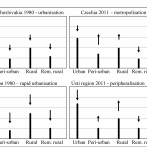A key issue in socio-economic geography is to understand how regional and social polarisation shapes the territorial organisation of society. We argue that effects of polarisation are not translated simply and straightforwardly in a whole region, but vary to a large extent with respect to different types of accessibility areas. We applied the time-accessibility framework to classify a territory into urban, peri-urban, rural, and remote rural areas at a national and regional scale. Subsequently, we computed comparative indicators for this territorial classification, measuring three dimensions of peripherality for a period of thirty years. The analysis illustrates how polarisation and peripheralisation works at a detailed spatial level. A case study of the Ústí region shows re-polarisation and bi-polarisation of the region in its path from socialist urbanisation in the 1980s to regional peripheralisation in 2011. The use of the time-accessibility framework allows to assess regional changes within long-term and broader changes of core-periphery relations at national level and thus allows for a better understanding of the different nature of socialist and post-socialist peripheries. Finally, the article offers methodical procedures and tools allowing for a comparable research of polarisation and peripheralisation. Thus, it is responding to the call for more comparative research of peripheral areas in Europe.
impaktovaný článek
Šimon, Martin. 2017. „Multi-scalar geographies of polarisation and peripheralisation: A case study of Czechia.“ Bulletin of Geography. Socio–economic Series 37 (3): 125-137. ISSN 1732–4254. [cit. 21.7.2017]. Dostupné z: http://apcz.umk.pl/czasopisma/index.php/BGSS/article/view/bog-2017-0029/12494.
Autoři:
Oddělení:
Témata:
město a vesnice
metodologie výzkumu
regiony
sociální nerovnosti
transformace
vzdělání




Facebook
X
Tweets by SociologickyNewsletter